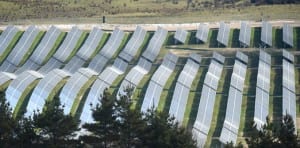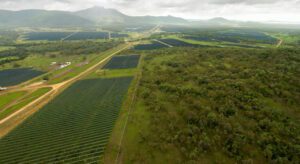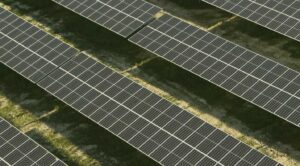A newly-formed solar development company is seeking approval from Queensland’s Gympie regional council for what it says will be Australia’s biggest solar farm, in yet another sign of the snowballing interest in large scale solar PV – and in storage.
The proposal for the Lower Wonga solar farm from SolarQ – comprising a couple of executives who have spent most of their time in the coal and gas industry – was first flagged last year, but has got more coverage in the 24 hours after it was revealed they had submitted a council application.
The project sounds hugely ambitious – 350MW in the first stage, a potential total of 800MW over several stages, and a significant amount of battery storage (up to 4,000MWh). The company is saying that at full capacity it is enough to supply 15 per cent of the electricity needs of the south-east corner of Queensland.
Whether it goes ahead remains to be seen. A bunch of other developers have touted equally big projects, only for them to be rolled out in bite sized chunks, or not at all.
Still, there are some 2,000MW of solar projects in Queensland at advanced stages of development and construction, there is more than 1,000MW in the pipeline in South Australia, including 220MW under construction, and Transgrid has reported 6,000MW of solar proposals in NSW alone.
And many of these proposals, it seems, are coming from people once ensconced in the coal industry, like Reach Solar’s Tony Concannon, who is the former head of the recently closed Hazelwood brown coal generator.
Like Concannon, SolarQ’s Scott Armstrong is saying that solar is already easily beating gas-fired generation, and so too will the combination with battery storage.
“If you asked me three months ago about battery storage, I would have said it was three-to-five years away,” Armstrong told RenewEconomy. “But the prices are falling so significantly and so quickly, that it now one year away.”
So much so, that Armstrong is targeting battery storage by the third quarter of 2018, with a well known “tier 1” battery storage provider.
Armstrong’s vision is to create a solar-storage “peaking plant”, that will take advantage of the huge “flex” in demand profiles in the local region.
This is a classic case of a fossil fuel industry veteran – Armstrong spent years maintaining coal plants and was a trader for Braemer gas generator and the Wivenhoe pumped hydro – seeing new solutions to old problems. “I’m calling it a solid-state peaking plant,” he says. Hence his need for a large amount of storage.
“In my old job I’d build a gas peaking plant,” Armstrong says. “You don’t want to have a baseload power plant in this environment. What you need is flex assets, because it has a large flexing customer base.”
And solar easily beats gas – a peaking plant, he says, has just fuel costs of a minimum $110/MWh “before you get out of bed” and “if you can find the gas”. Building more solar means freeing up more gas for the markets elsewhere. Even Santos agree on that one, hence their interest in supporting Ross Garnaut’s solar and storage plans in South Australia.
SolarQ is saying that the Lower Wonga project should begin construction by the end of the year. Apart from the fact that it has yet to get council approval – although this should be no great problem judging by the comments of the local mayor – it has yet to lock in investors and finance.
Armstrong says that will come after council approvals and other approvals are locked in. But he says there is a big advantage in being located within 2 hours of Brisbane and on a major highway – both in logistics, and in market (there is less transmission losses than from a remote location).
“We have already got pricing for up to 350MW that are significantly below the numbers you see in the market today,” Armstrong says.
“There are significant economies of scale. We believe the market will come and gobble up the project. The energy will be consumers within 100kms of the project development. It is not a fringe development. We will better anything on the market from pricing point of view. It’s really quite exciting.”









